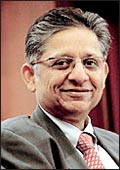 |
 |
| Citibank's Sharma and ABN AMRO
Bank's Sobti: Focussing to expand client base |
When
the 153-year-old Standard Chartered Bank recently decided it was
time to foray into rural India, it pounced on a 15-member team
of Barclays Bank in South Africa. For Stanchart, which has no
agriculture-related operations globally, the acquisition was important
as the Barclays team had done agriculture finance all along and
had intimate knowledge of the agriculture value chain. The 15-member
team is now busy writing the rural India strategy for the bank.
Stanchart is expected to make a small beginning in four to six
months, and ramp it up in 2007.
Meantime, in Citigroup's swank suburban headquarters,
the theme is slightly different: It's wealth management, and the
group is busy sewing together its India blueprint, right from
the retail broking level. Elsewhere, at ABN AMRO, commodity trading
and broking is the latest gap in the portfolio that is being plugged.
HSBC is preparing to lend to the small & medium enteprises
sector as well as flag off private banking. And Deutsche Bank
plans to roll out the entire gamut of retail products over the
next 2-3 years.
Five years ago, a foreign bank going rural
would be unthinkable. Today, there are over two dozen foreign
banks jostling for space in businesses traditonally regarded as
'untouchables'. As growth in developed economies nears saturation
levels, it's emerging markets like China, Eastern Europe, Latin
America and India that are the new growth engines. "Our strategy
is to go down the pyramid and develop a much larger client base.
In fact, as a bank today we are more local than foreign,"
says Sanjay Nayar, CEO, Citibank.
He's not the only one thinking mass. Standard
Chartered's non-banking finance company (NBFC), which started
operations in August 2005, has already set up 21 branches; the
plan is to go up to 60 in the next 4-5 months. Amazingly the average
ticket size of Stanchart's personal loans is just Rs 30,000-35,000,
and it rarely goes above Rs 50,000. Awaiting an rbi licence for
an NBFC is HSBC India, which is also eyeing the Rs 50,000-1 lakh
consumer loan bracket. "Our top priority is financial inclusion
and serving under-banked areas," says Naina Lal Kidwai, Country
Head and CEO, HSBC India. On ABN AMRO's radar are smaller cities
like Panipat, Nasik, Udaipur and Salem. Adds Neeraj Swaroop, CEO
(India), Standard Chartered Bank: "The game is about who
owns the customer."
Whilst on the one hand the game is about
introducing more people to organised banking, it's also about
ensuring that you don't lose a customer to a competitor because
you don't provide a particular service. That's why almost every
foreign bank is attempting to plug the gaps that exist in its
portfolio. What's more, if banks do get into retail broking, they'd
enjoy an edge over traditional broking firms. For, as Romesh Sobti,
Country Executive (India), ABN AMRO Bank NA, points out: "People
trust their bank the most. And if a multinational bank with a
strong brand behind it comes calling, this factor comes more into
play."
"We have superior research quality,
tested asset allocation processes and risk management tools,"
claims Deepak Sharma, CEO (Global Wealth Management) at Citibank
NA who is spearheading the wealth mananagement forays of Citigroup
including retail broking. Clearly retail investors are a huge
opportunity for the foreign banks, many of them are using their
asset management companies (ANCs) as a vehicle for such forays.
Traditionally a debt house, Standard Chartered AMC is now aggressively
looking at equity business. ABN AMRO AMC is launching portfolio
management services (PMS) via the mutual fund route. Deutsche
Bank has brought in its most popular DWS brand for its asset management
business in India. And Citibank is also eyeing commodities trading.
On the corporate side, the foreign banks
which traditionally focussed on top 100 or 200 corporates are
now focussing on the middle market. "Today, the needs of
SMEs which are exposed to global markets are much more than working
capital or trade financing," says Bala Swaminathan, co-head
(wholesale banking ) at Standard Chartered Bank. "Corporate
clients today need intellectual capital and risk management solutions
and advisory products," adds Gunit Chadha, Managing Director
& CEO, Deutsche Bank India. Citibank today has an SME portfolio
of over a billion dollars.
The race is not only for good assets; the
foreign banks are equally gung ho about tapping the market for
bad assets. "We are open to look at stressed retail portfolios
as and when this category matures," discloses Chadha of Deutsche
Bank. "We have experience in (retail) collections and we
are looking at retail stressed assets. In fact, we do it in Korea,
Japan and other countries," adds Citibank's Nayar. abn amro
is looking at a possibility of taking distressed assets onto its
books, while Standard Chartered has signed a memorandum of understanding
for an asset recovery jv with four banks (j&k, obc, ubi and
Central Bank) and also created an inhouse asset recovery division
within the bank.
"Real estate will be a very large opportunity
going forward. We are looking at the entire spectrum-lending,
securitisation, equity investment and capital market. There are
also opportunities in infrastructure financing, especially in
the areas of ports, roads, power and SEZs," says Nayar. Citi
and the rest of the foreign bank pack have their hands full for
the next few years.
-Anand Adhikari
Sahara's
Property Play
Housing is turning out to be Subrata Roy's
biggest gambit yet.
These
may not be the best of times for the Sahara India Pariwar, but
the frenetic activity at one of the companies, Sahara Infrastructure
& Housing, belies the theory that the conglomerate is fast
sinking. As of April, the company claims to have acquired all
of 20,000 acres of land. And it isn't stopping at that. Sunder
Lal, Head of Sahara Infrastructure & Housing (who reports
to Chairman Subrata Roy), says the target is 60,000 acres across
217 towns, in which the company will build its townships, under
the banner of Sahara City Homes. The size of the townships will
range between 100 and 360 acres. Sahara claims to have roped in
reputed architects like Hafeez Contractor (who has designed the
townships), as well as Bechtel, L&T and Otis for technical
support.
Lal points out that the value of the land
acquired so far (excluding the Amby Valley project in western
India) would be roughly Rs 20,000 crore at today's prices, and
the cost of acquisition would be much lower than half that amount-he's
not giving the exact figure. What he's willing to say is that
the total cost for acquiring 60,000 acres won't be more than Rs
18,000-20,000 crore. The math is doubtless intriguing, but even
more is the source of all that money.
-Brian Carvalho
Big Appetite
Navis likes food, but won't live by it alone.
 |
| Navis' Bloy (left) & Nirula's
Kuckreja : A palatable order |
With
$500 million (Rs 2,350 crore) under management, Navis is not by
any stretch one of Asia's largest private equity (PE) funds. Yet,
what sets the Malaysia-based PE firm apart from the rest in the
region is its appetite for the food retailing business. In Asia
it has invested in KFC in Hong Kong, Dunkin Donuts in Thailand
and Dome Coffee, an Australasian restaurant chain. In mid-July,
the mid-sized PE firm bought into Wendy's ice cream sundaes business
in Australia. Such a hunger for food companies is evident in India
too. Navis along with Samir Kuckreja recently made its third investment
in the country by buying out north-India based fast food chain
Nirula's for Rs 90 crore. Navis had earlier bought 74 per cent
stake in two companies owned by Mumbai-based entrepreneur, Sanjay
Narang-Sky Gourmet Catering, and Mars Hotels & Restaurants.
Last fortnight Nicholas R.H. Bloy, Director,
Navis, visited Delhi to blueprint Nirula's future course with
new Managing Director and part-owner Samir Kuckreja, nephew of
erstwhile owner Lalit Nirula. Kuckreja owns under 10 per cent
of Nirula's while Navis holds the rest. "Over the next three
years Rs 100-150 crore will be spent on revitalising the chain,"
says Kuckreja, who has been common to Navis' investments in India.
Prior to returning to Nirula's, Kuckreja headed Mars Hotels.
Navis' current average internal rate of return
is 3.5-4.5 times the original equity cost. Bloy says Navis can
pull this off because the partners themselves roll up their sleeves
like typical entrepreneurs. "We are small in Asia, but we
make more money than others do," quips Bloy.
For Navis, food is one of the most "empirically
analysable business." Simply put, not only is it possible
for Navis to link the profitability of an outlet to its location
and its socio-economics, it is also possible for the firm to assess
future profitability. "The range of uncertainty in any retail
concept is much narrower than in say technology."
Then, Navis is not foraging only for food
in India. Bloy is ready to invest up to $300 million (Rs 1,410
crore) over the next five years in India. "Any business related
to consumer spending or even the light industrial sectors would
be interesting." Navis is in talks with a packaging company
and another that supplies storage tanks and pipelines, and expects
to close at least one deal by 2006-end.
Exit options are clearly in sight. Navis
likes to be present in segments where there is no dearth of multinational
companies as buyers. A case in point is Drypers Malaysia. Navis
bought the baby diaper company for $10 million, stayed with it
for three years and then sold it to a Swedish multinational for
$94 million. In the interim, Drypers rose from #3 in the market
to top dog in South-East Asia in market share, beating Pampers
and Huggies. Now which are the MNCs watching Nirula's and Mars?
-Shalini S. Dagar
|







